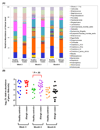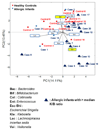Ratio of Klebsiella/Bifidobacterium in early life correlates with later development of paediatric allergy
- PMID: 29022383
- PMCID: PMC5724753
- DOI: 10.3920/BM2017.0020
Ratio of Klebsiella/Bifidobacterium in early life correlates with later development of paediatric allergy
Abstract
Several studies have reported that intestinal microbial colonisation patterns differ between non-allergic and allergic infants. However, the microbial signature underlying the pathogenesis of allergies remains unclear. We aim to gain insight into the development of the intestinal microbiota of healthy infants and infants who develop allergy in early life, and identify potential microbiota biomarkers of later allergic disease. Using a case-control design in a Chinese sub-cohort of a Singaporean birth cohort (GUSTO), we utilised 16S rRNA gene sequencing to assess intestinal microbial composition and diversity of 21 allergic and 18 healthy infants at 3 weeks, 3 months and 6 months of age, and correlated the microbiota with allergy at ages 18 and 36 months. Pronounced differences in intestinal microbiota composition between allergic and healthy infants were observed at 3 months of age. The intestine of healthy infants was colonised with higher abundance of commensal Bifidobacterium. Conversely, Klebsiella, an opportunistic pathogen, was significantly enriched in the allergic infants. Interestingly, infants with a high Klebsiella/Bifidobacterium (K/B) ratio (above the population median K/B ratio) at age 3 months had an odds ratio of developing allergy by 3 years of age of 9.00 (95% confidence interval 1.46-55.50) compared to those with low K/B ratio. This study demonstrated a relationship between the ratio of genera Klebsiella and Bifidobacterium during early infancy and development of paediatric allergy in childhood. Our study postulates that an elevated K/B ratio in early infancy could be a potential indicator of an increased risk of allergy development. This line of research might enable future intervention strategies in early life to prevent or treat allergy. Our study provides new insights into microbial signatures associated with childhood allergy, in particular, suggests that an elevated K/B ratio could be a potential early-life microbiota biomarker of allergic disease.
Keywords: 16S rRNA; Bifidobacterium spp.; Enterobacteriaceae; atopic dermatitis; eczema.
Conflict of interest statement
The authors June S. Y. Low, Eline M. Van Der Beek, Jan Knol and Christophe Lay are employees of Nutricia Research. KMG has received reimbursement for speaking at conferences sponsored by companies selling nutritional products, and is part of an academic consortium that has received research funding from Abbott Nutrition, Nestec and Danone.
Figures




References
-
- Abrahamsson TR, Jakobsson HE, Andersson AF, Bjorksten B, Engstrand L, Jenmalm MC. Low diversity of the gut microbiota in infants with atopic eczema. J Allergy Clin Immunol. 2012;129:434–440. 440 e431-432. - PubMed
-
- Abrahamsson TR, Jakobsson HE, Andersson AF, Bjorksten B, Engstrand L, Jenmalm MC. Low gut microbiota diversity in early infancy precedes asthma at school age. Clin Exp Allergy. 2014;44:842–850. - PubMed
-
- Aloisio I, Santini C, Biavati B, Dinelli G, Cencic A, Chingwaru W, Mogna L, Di Gioia D. Characterization of Bifidobacterium spp. strains for the treatment of enteric disorders in newborns. Appl Microbiol Biotechnol. 2012;96:1561–1576. - PubMed
-
- Arrieta MC, Stiemsma LT, Dimitriu PA, Thorson L, Russell S, Yurist-Doutsch S, Kuzeljevic B, Gold MJ, Britton HM, Lefebvre DL, Subbarao P, et al. Early infancy microbial and metabolic alterations affect risk of childhood asthma. Sci Transl Med. 2015;7:307ra152. - PubMed
MeSH terms
Substances
Grants and funding
LinkOut - more resources
Full Text Sources
Other Literature Sources
Medical
Miscellaneous

